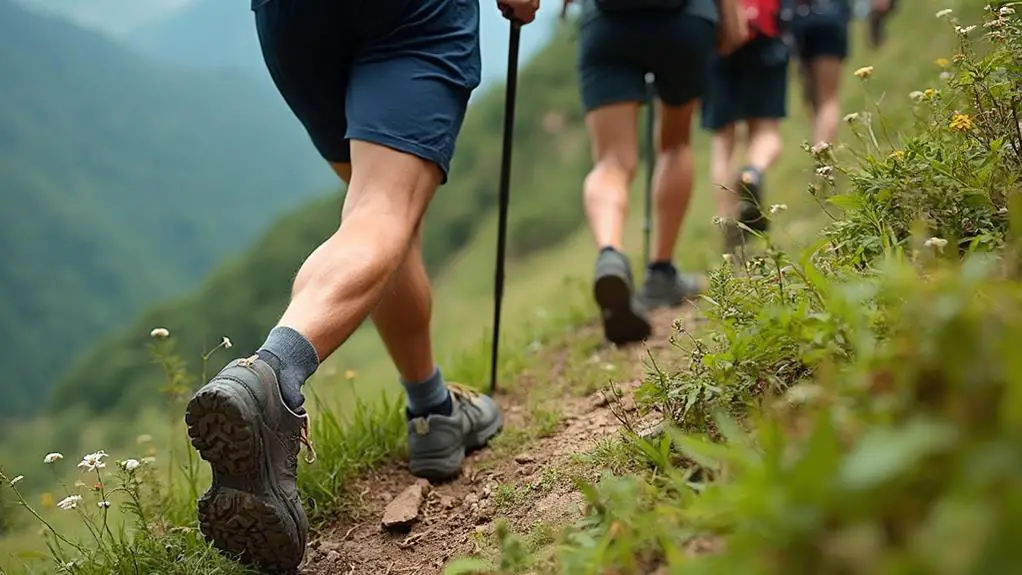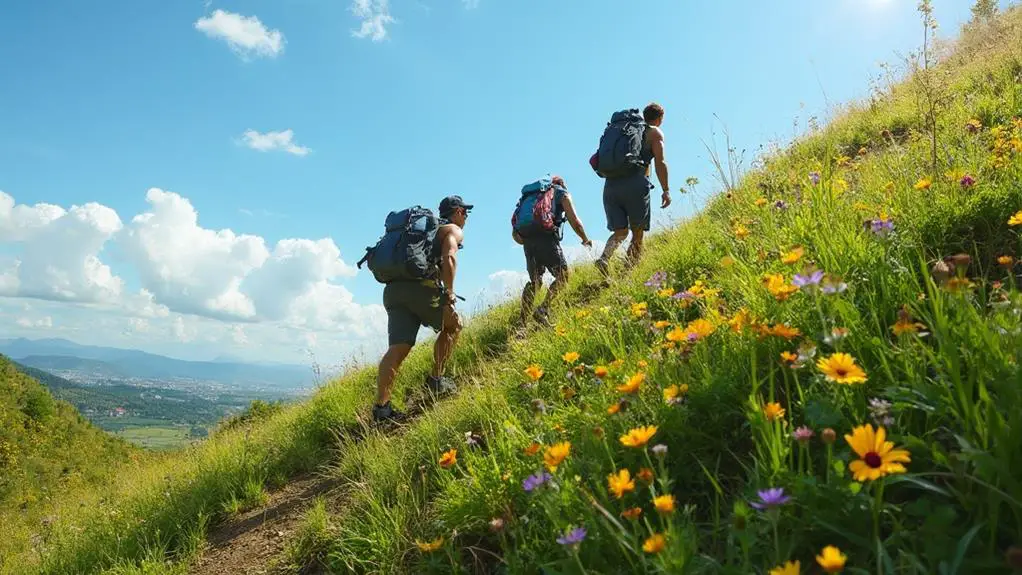Walking uphill challenges hikers' leg muscles by activating major groups such as quadriceps, hamstrings, calves, and glutes, thereby enhancing functional fitness. This intensive workout requires greater force production than flat terrain, improving muscle coordination and reducing injury risk. Uphill strides also bolster core strength, essential for stability, balance, and injury prevention. Cardiovascular benefits arise from increased heart rates and caloric burn, boosting endurance. Additionally, it promotes bone health through osteoblast activity, decreasing osteoporosis risk. The combined coordination of muscle activation and cardiovascular effort makes uphill hiking a thorough workout, with further insights awaiting exploration.
Key Takeaways
- Uphill hiking activates major leg muscle groups, enhancing strength and functional fitness.
- It improves stability, balance, and core strength, reducing injury risk on uneven terrain.
- Elevates heart rate significantly, boosting cardiovascular fitness and endurance.
- Increases energy expenditure, improving muscular endurance and aiding in osteoporosis prevention.
- Promotes mental wellness through nature exposure, reducing stress and enhancing mood.
Engaging Multiple Muscle Groups
Hiking uphill consistently engages multiple muscle groups, making it an efficient form of exercise for thorough leg development. This activity demands the coordinated action of the quadriceps, hamstrings, calves, and glutes, each playing a significant role in propelling the body against gravity. The incline necessitates greater force production compared to flat terrain, leading to enhanced muscle activation. Such engagement underscores the importance of muscle coordination, as the synchronized efforts of these groups contribute to functional fitness.
This coordination is essential not only for ideal movement efficiency but also for preventing injuries by ensuring that no single muscle group bears excessive load.
Furthermore, the dynamic nature of uphill hiking promotes stability and balance, key components when dealing with uneven or steep inclines. This aspect of functional fitness is fundamental for hikers, as it allows them to traverse challenging landscapes safely and effectively.
Additionally, the all-encompassing workout provided by uphill hiking addresses potential muscle imbalances, supporting overall muscular harmony and endurance. By demanding the concerted effort of various muscle groups, uphill hiking emerges as a superior form of exercise, offering both immediate benefits in calorie expenditure and long-term improvements in leg function and coordination.
Building Leg Strength

While engaging in uphill hiking, a primary outcome is the development of thorough leg strength, which is essential for maneuvering steep terrains effectively. This form of exercise primarily targets the quadriceps, hamstrings, glutes, and calves, offering a holistic approach to strengthening the lower body. Such robust development is instrumental in reducing fatigue and the likelihood of experiencing "jelly legs," thereby enhancing hiking performance on challenging trails. Strength training exercises, such as barbell step-ups and squats, complement this natural strengthening process, leading to improved leg power and endurance.
| Muscle Group | Exercise Benefits |
|---|---|
| Quadriceps | Increases power for ascending |
| Hamstrings | Enhances stride efficiency |
| Glutes | Provides propulsion on inclines |
| Calves | Supports ankle stability |
| Combined Groups | Reduces fatigue and risk of injury |
Incorporating regular strength training can optimize muscle recovery, allowing hikers to sustain prolonged activity without undue strain. By targeting these muscle groups specifically, hikers not only enhance their muscular balance but also mitigate injury risks. This strategic focus on leg strength guarantees that hikers can tackle steep, uneven surfaces with increased confidence and reduced exertion. Such training is indispensable for those seeking to boost their hiking capabilities and enjoy the great outdoors with vigor and safety.
Enhancing Stability and Balance
Traversing uneven terrain during hikes demands a high level of stability and balance, underscoring the importance of targeted training for these attributes. Uphill walking serves as an effective method to enhance both stability and balance through the engagement of multiple muscle groups. This activity primarily targets the quadriceps, hamstrings, and calves, which collectively fortify leg strength and contribute to stability strategies.
The incline also increases the demand on core muscles, which are vital for maintaining balance as hikers navigate uneven landscapes.
Benefits of Uphill Walking:
- Enhanced Leg and Core Strength: Strengthening these muscles improves proprioception, enabling hikers to make precise adjustments on steep inclines.
- Improved Muscular Endurance: Regular uphill walking builds endurance, thereby reducing fatigue and sustaining stability during extended hikes.
- Reduced Risk of Falls: With strengthened muscles and enhanced proprioception, hikers experience better stability, decreasing the likelihood of slips and falls.
The scientific underpinning of these benefits is clear: the physiological adaptations from uphill walking translate to improved performance in various hiking conditions.
Improving Cardiovascular Fitness

Improving cardiovascular fitness is paramount for hikers aiming to enhance heart health and boost endurance levels.
Empirical evidence indicates that walking uphill considerably raises heart rate and caloric expenditure, which contributes to enhanced cardiovascular efficiency and endurance.
Consequently, regular uphill hiking can lead to better circulation, reduced resting heart rates, and a lower risk of cardiovascular diseases, thereby equipping hikers with the physiological resilience needed for demanding trails.
Enhance Heart Health
Uphill hiking serves as a formidable means of enhancing cardiovascular fitness by significantly elevating heart rate and promoting efficient blood circulation throughout the body. As hikers ascend inclines, their cardiovascular system works harder to supply oxygen-rich blood to muscles, thereby strengthening the heart muscle.
This process not only enhances the heart's efficiency in pumping blood but also mitigates the risk of heart disease. Scientific studies corroborate that regular uphill hiking can lead to substantial improvements in cardiovascular markers, such as reduced resting heart rate and lowered blood pressure.
The cardiovascular benefits of uphill hiking can be attributed to several key aspects:
- Caloric Expenditure: Uphill hiking can burn approximately 430-480 calories per hour, which contributes to weight management and cardiovascular health.
- Oxygen Uptake: This activity improves oxygen uptake and lung capacity, essential for maintaining a healthy cardiovascular system.
- Heart Muscle Strengthening: Regular engagement in uphill hiking fortifies the heart muscle, making it more efficient at circulating blood.
Boost Endurance Levels
Endurance, a vital component of physical fitness, is greatly improved through uphill hiking due to its ability to raise heart rates and engage large muscle groups more intensely than walking on flat terrain. This elevation in heart rate not only boosts cardiovascular fitness but also promotes caloric expenditure, with hikers burning approximately 430-480 calories per hour.
Such energy demands enhance stamina and facilitate muscle recovery by increasing blood flow, delivering essential nutrients, and removing metabolic waste products.
Scientifically, consistent uphill hiking has shown to improve VO2 max, a primary metric for cardiovascular efficiency, by up to 15% in trained individuals. This improvement signifies enhanced aerobic capacity, allowing the body to utilize oxygen more effectively during prolonged physical activity.
Additionally, the activation of larger muscle groups during uphill hikes results in a thorough workout that contributes to increased endurance levels.
Incorporating uphill terrain into regular hiking routines is a strategic training technique that can improve lung capacity and cardiac efficiency. These adaptations are essential for long-term cardiovascular health.
Increasing Endurance

Tackling uphill terrain is a powerful strategy for enhancing cardiovascular and muscular endurance among hikers. As the heart pumps more blood to the working muscles, aerobic capacity is markedly boosted, enabling sustained physical activity.
Implementing interval training during uphill hikes can further optimize endurance gains. By alternating between periods of intense uphill effort and recovery techniques, hikers can enhance both aerobic and anaerobic endurance. Interval training allows the cardiovascular system to adapt to increased demands, ultimately improving stamina and energy efficiency during prolonged exertion.
The physiological benefits of uphill walking are underscored by evidence indicating a 50-70% increase in energy expenditure compared to flat terrain. This considerable rise in energy consumption enhances muscular endurance in the legs, allowing hikers to maintain high levels of exertion over extended periods without succumbing to fatigue.
The key benefits of uphill hiking include:
- Increased aerobic capacity – Enhanced oxygen utilization improves endurance.
- Improved muscular durability – Strengthens muscles to resist fatigue.
- Enhanced cardiovascular efficiency – Promotes better blood flow and stamina.
Consistent uphill walking not only fortifies the leg muscles but also strengthens the cardiovascular system. This all-encompassing approach to endurance training guarantees hikers are well-prepared for the demands of long and challenging hikes.
Strengthening Core Muscles

Strengthening core muscles is essential for hikers, as it enhances both core stability and hiking posture.
Empirical evidence suggests that a robust core not only supports better balance and stability on inclines but also contributes to improved posture and alignment, vital for preventing back pain during prolonged hikes.
Core Stability Benefits
Regularly engaging in uphill walking greatly enhances core stability by activating the abdominal and oblique muscles, which are vital for maintaining balance on steep inclines.
Core strength, a key component of stability training, is markedly improved through this activity. Uphill walking not only stabilizes the body but also optimizes power transfer between the upper and lower body, leading to increased movement efficiency.
This efficient power transfer is essential during demanding hikes, allowing hikers to conserve energy and reduce fatigue.
The benefits of strengthening core muscles through uphill walking extend beyond immediate performance improvements:
- Injury Prevention: A strong core reduces the risk of back injuries by providing vital support to the spine during strenuous climbs.
- Enhanced Endurance: Core stability contributes to prolonged hiking endurance, enabling hikers to tackle longer and more challenging trails with ease.
- Improved Control: Activating stabilizer muscles helps maintain better control over body movements, minimizing fatigue during prolonged activities.
Research underscores the importance of core stability in enhancing hiking performance.
By incorporating uphill walking into regular stability training, hikers can achieve greater endurance and control, thereby maximizing their overall hiking experience.
This evidence-based approach to core strengthening guarantees safer and more efficient hiking ventures.
Enhancing Hiking Posture
A essential aspect of optimizing hiking performance lies in enhancing one's hiking posture through the strengthening of core muscles. Core strength is imperative for posture alignment, ensuring stability during uphill ascents and mitigating the risk of injury.
Effective muscle activation of the abdominal and lower back muscles, achieved through exercises such as planks and rotational movements, supports the spine and enhances overall balance. This is particularly beneficial on uneven terrains encountered during hikes.
A robust core aids in efficient weight distribution, an important factor in conserving energy and maintaining endurance over prolonged uphill treks. By fostering an upright posture, a strong core minimizes fatigue and discomfort by alleviating strain on the legs and back, which are essential for sustained physical activity in steep environments.
Scientific research underscores the significance of core training, demonstrating a potential increase in hiking performance by up to 15%. This quantifies the impact of targeted core exercises on posture alignment and energy efficiency during uphill hiking.
Consequently, integrating core strengthening routines into regular training can markedly improve hiking dynamics, underscoring its role as a fundamental component in enhancing hiking posture and overall performance.
Boosting Calorie Burn

Hiking presents a unique opportunity for boosting calorie burn, particularly through the incorporation of uphill walking. Utilizing incline variations, individuals can effectively enhance their workout intensity.
Calorie tracking becomes pivotal as walking uphill can burn approximately 430-480 calories per hour, a figure considerably higher than that of flat terrain walking. This increased calorie expenditure is attributed to the engagement of more muscle groups, especially in the lower body.
The physiological demands of uphill hiking are notable, with research indicating that a 10% gradient can double calorie burn compared to flat walking. This is primarily due to the heightened effort required to ascend, which engages large muscle groups and raises the heart rate to between 70-85% of its maximum.
Such activity not only enhances cardiovascular fitness but also contributes to effective weight management.
Key Findings:
- Calorie Burn: Uphill walking can burn up to 480 calories per hour.
- Heart Rate: Increases to 70-85% of maximum, improving cardiovascular health.
- Muscle Engagement: Inclines activate more muscle groups, enhancing energy expenditure.
Incorporating elevation gains into hiking routines not only optimizes calorie burn but also fortifies muscle tone and strength in the legs.
Reducing Injury Risk

Frequently, uphill walking emerges as a key strategy in reducing injury risk for hikers by targeting multiple leg muscle groups, including the quadriceps, hamstrings, and calves. This multifaceted approach enhances muscle strength and balance, vital components of effective injury prevention strategies. By fortifying these muscle groups, uphill walking mitigates the risk of muscle imbalances, which are often precursors to injuries. Strengthened muscles contribute to stabilizing joints and improving proprioception, essential for traversing uneven terrain and minimizing falls.
| Benefits of Uphill Walking | Emotional Impact |
|---|---|
| Enhanced Joint Stability | Confidence |
| Improved Proprioception | Safety |
| Reduced Muscle Imbalance | Empowerment |
The controlled movements and balance required during uphill hikes foster superior body mechanics, thereby reducing the likelihood of strains and sprains. Additionally, gradually increasing trail difficulty allows the body to adapt progressively, minimizing overuse injuries associated with abrupt intensity changes. This adaptation is a key component of extensive injury prevention strategies.
Strengthening leg muscles through uphill walking also alleviates pressure on the knees and lower back, decreasing the risk of chronic pain and associated injuries. This approach highlights the importance of muscle imbalance awareness and provides a robust framework for safe hiking practices.
Promoting Bone Health

Uphill walking plays a significant role in enhancing bone density by stimulating bone remodeling processes, which are essential for maintaining the structural integrity of bones, particularly in weight-bearing regions such as the legs and spine.
The mechanical stress generated during uphill walking promotes the activity of osteoblasts, thereby reducing the risk of osteoporosis by fostering bone formation.
Regular engagement in uphill hiking has been shown to lower the incidence of age-related bone loss, highlighting its efficacy in promoting long-term skeletal health and reducing the likelihood of fractures.
Enhancing Bone Density
One of the most effective strategies to enhance bone density is engaging in weight-bearing activities that challenge the skeletal system.
Walking uphill is particularly beneficial as it induces bone remodeling through stress adaptation. When bones are subjected to the increased gravitational force of uphill walking, they respond by strengthening their structure, a process known as bone remodeling. This is essential for maintaining bone health, especially in areas prone to weakening, such as the hips and spine.
Research supports that uphill hiking can greatly increase bone mineral density. This is vital for populations at risk of bone density loss, such as postmenopausal women. Studies demonstrate that consistent uphill hiking, ideally performed three times a week, effectively contributes to bone health.
The benefits of this activity are significant:
- Increased bone mineralization: Uphill walking stimulates the deposition of minerals in bones.
- Enhanced structural strength: Regular stress adaptation from hiking improves bone robustness.
- Sustained density improvements: For every 1% increase in physical activity, there can be a 1-3% improvement in bone density.
Therefore, incorporating uphill walking into regular exercise routines can be a strategic intervention for enhancing bone density and promoting overall skeletal health.
Reducing Osteoporosis Risk
Walking uphill serves as a potent weight-bearing exercise that greatly aids in reducing the risk of osteoporosis, a condition characterized by weakened bones and increased fracture risk. This form of exercise stimulates bone formation and enhances bone density, making it an essential strategy for osteoporosis prevention.
Research indicates that regular participation in weight-bearing activities such as uphill hiking can lower the risk of osteoporosis by up to 50% in postmenopausal women, a demographic particularly susceptible to this condition.
Uphill hiking effectively strengthens bones in the legs, hips, and spine—areas most vulnerable to osteoporotic fractures. The increased gravitational force experienced during ascent not only promotes bone health by enhancing calcium retention but also contributes to overall skeletal resilience.
Scientific evidence supports the notion that consistent uphill walking can bolster bone density while simultaneously improving muscle strength, balance, and coordination. These physiological adaptations are significant in reducing fall risk and potential fractures, consequently offering a thorough approach to osteoporosis prevention.
Incorporating uphill walking into one's routine can thus serve as an integral component of a holistic strategy to promote bone health and mitigate the debilitating effects of osteoporosis.
Enhancing Mental Wellness

The mental-health benefits of engaging in uphill hiking are underscored by a growing body of scientific evidence. This activity not only boosts physical fitness but also considerably enhances mental wellness through various mechanisms.
To begin with, the meditative environment of nature fosters mindfulness practices that reduce stress levels and enhance mental resilience. The act of focusing on the present moment amidst nature can lead to decreased anxiety and improved mood.
Furthermore, social connections formed during group hikes provide an essential support network, further promoting mental wellness by reducing feelings of isolation and fostering a sense of community.
Empirical data highlights several key mental health benefits associated with uphill walking:
- Mood Improvement: The production of endorphins during uphill hiking raises mood and alleviates symptoms of anxiety and depression.
- Cognitive Enhancement: Increased blood flow and oxygen to the brain during hikes have been linked to improved cognitive function, memory retention, and mental clarity.
- Stress Reduction: Regular physical activity, including uphill walking, has been shown to reduce cortisol levels, thereby promoting a calmer, more balanced state of mind.
Ultimately, uphill hiking represents a multifaceted approach to mental wellness, combining physical exertion with psychological and social benefits.
Accessibility for All Levels

Engaging in uphill hiking can be seamlessly tailored to suit individuals across various fitness levels, thanks to the customizable nature of trail gradients and distances. This adaptability is supported by the availability of diverse trail options within many local parks and nature reserves. Such trail variety accommodates both beginners and seasoned hikers, allowing individuals to select routes that match their specific fitness capabilities.
The minimal equipment required, such as comfortable shoes and weather-appropriate clothing, further facilitates accessibility, reducing the need for extensive preparation or financial investment.
Furthermore, the incorporation of group dynamics into hiking programs enhances accessibility, as guided experiences often cater to new hikers. These programs guarantee safe participation through structured guidance, fostering an inclusive environment where individuals of all backgrounds can engage in uphill hiking.
This communal approach not only provides support but also encourages adherence to regular activity, which is integral for improving leg strength and endurance over time. Additionally, the integration of uphill walking into daily routines—such as choosing stairs over elevators or utilizing local hills—demonstrates the practicality of this exercise modality.
Cost-Effective Workout

Uphill hiking stands out as a cost-effective workout due to its minimal equipment requirements and the accessibility of natural environments. This affordable fitness option requires only sturdy footwear and weather-appropriate clothing, making it accessible to a broad range of individuals.
In contrast to gym memberships or specialized fitness classes, uphill hiking eliminates the need for expensive facilities or travel, as it can be conducted in local parks or nature reserves. This form of outdoor exercise not only reduces financial barriers but also provides an effective full-body workout by engaging multiple muscle groups without the necessity for costly machines or weights.
The benefits of uphill hiking as an affordable fitness regimen are threefold:
- Cost Savings: It circumvents the financial commitments associated with gym memberships and travel expenses.
- High-Calorie Burn: Approximately 430-480 calories can be burned per hour, offering significant energy expenditure.
- Accessibility: Trails cater to various fitness levels, allowing tailored workouts without further financial investment.
These elements contribute to the efficacy and appeal of uphill hiking as an inclusive and economically sustainable exercise option, supporting both physical health and financial wellbeing in a natural setting.
Exploring Nature's Benefits

Beyond the financial advantages of uphill hiking, engaging with nature provides multifaceted benefits that extend to both physical and mental well-being. The concept of nature therapy underscores the therapeutic effects of environmental immersion, which have been substantiated by scientific research. For instance, exposure to natural environments during uphill hikes considerably reduces symptoms of anxiety and depression, enhancing mental health. This phenomenon is attributed to the calming effects of nature sounds and sights, which promote relaxation and stress reduction.
The physical benefits of hiking uphill further complement these mental advantages. Walking uphill engages major muscle groups such as the quadriceps, hamstrings, and glutes, leading to improved leg strength and endurance. Additionally, this activity serves as an effective cardiovascular workout, boosting heart health by increasing heart rate and enhancing circulation. Regular participation also contributes to increased bone density, mitigating the risk of osteoporosis, particularly in aging populations.
| Benefit | Description |
|---|---|
| Mental Health Improvement | Reduces anxiety and depression through nature therapy |
| Muscle Engagement | Strengthens major muscles like quadriceps and glutes |
| Cardiovascular Health | Boosts heart health via improved circulation |
| Skeletal Health | Enhances bone density, reducing osteoporosis risk |
Frequently Asked Questions
Is Walking Uphill a Good Leg Workout?
Walking uphill is an excellent leg workout, providing substantial calorie burning and endurance training. It engages key muscle groups, enhances cardiovascular health, and improves balance and stability, making it an effective, evidence-based approach to leg strength and development.
Is Hiking Uphill a Good Workout?
Hiking uphill is an effective workout, offering significant cardio benefits and robust endurance training. It engages major leg muscles, enhances cardiovascular health, and improves stability, making it a thorough exercise for strength and fitness enhancement.
What Muscles Does Hiking Uphill Work?
Hiking uphill effectively targets muscle groups, particularly enhancing quadriceps activation and calf endurance. This activity demands coordinated engagement of the quadriceps, hamstrings, glutes, and calves, fostering increased strength, stability, and endurance, thereby reducing injury risks and improving overall performance.
What Leg Muscles Are Used When Walking Uphill?
When walking uphill, significant quadriceps activation occurs as these muscles extend the knee. Additionally, calf engagement is vital for lifting the heel and maintaining balance, with the gastrocnemius and soleus providing essential support during the push-off phase.
Conclusion
Walking uphill serves as a thorough leg workout by engaging various muscle groups, thereby enhancing leg strength and stability. This activity not only improves cardiovascular fitness and increases endurance but also contributes to mental wellness through the meditative aspects of nature exploration. Its accessibility to all fitness levels and cost-effectiveness further emphasize its benefits. The integration of physical and psychological advantages underscores walking uphill as an ideal exercise modality for enhancing overall health and well-being.